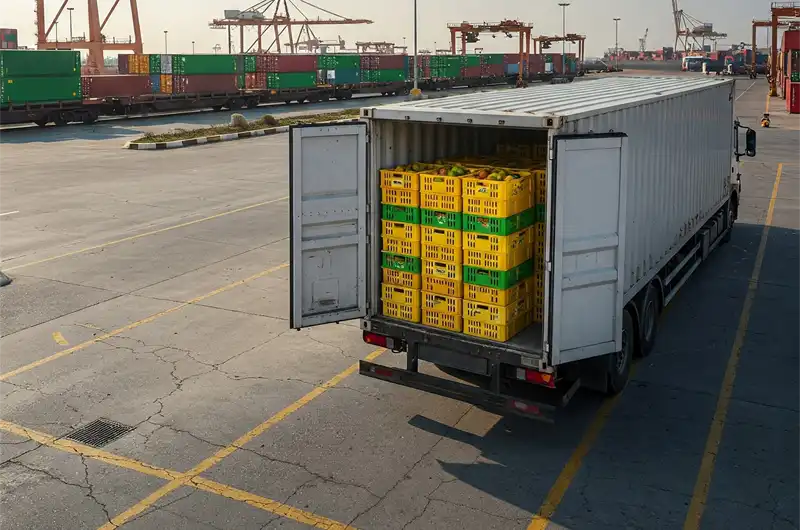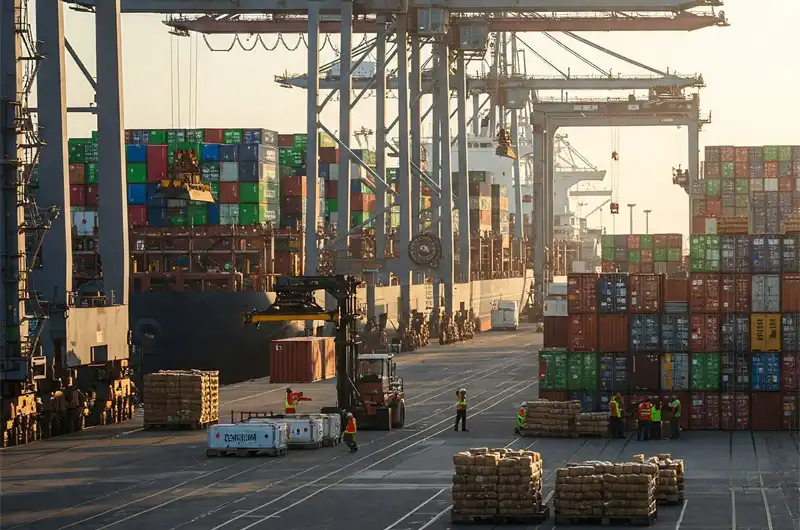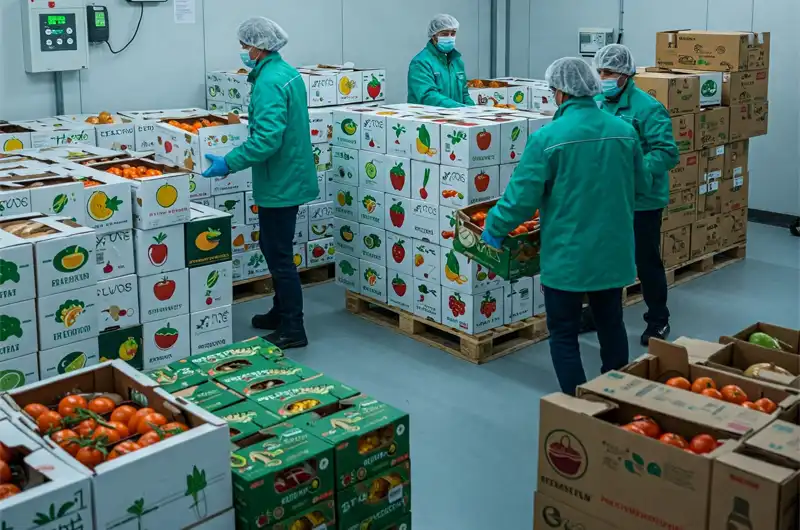Agricultural export logistics form the critical pathway connecting farms worldwide to consumers and industries across the globe. For producers aiming to tap into international markets, understanding and optimizing this intricate network of transportation, storage, and regulatory compliance is not just beneficial—it’s essential for success. This guide delves into the core aspects of moving agricultural products efficiently and effectively from domestic fields to global consumers.
Understanding Agricultural Export Logistics: The Backbone of Farm-to-Globe Trade
Effective agricultural export logistics involve a series of coordinated activities designed to move products from the point of harvest to the international buyer while maintaining quality, minimizing costs, and adhering to complex international and national regulations.

Why Efficient Logistics Matters for Agricultural Exporters
Streamlined logistics in agricultural exports directly impacts profitability and market competitiveness. Efficient systems lead to:
- Reduced Spoilage: Especially crucial for perishable goods, timely and temperature-controlled transit minimizes losses.
- Lower Costs: Optimized routes, transportation modes, and reduced delays save money.
- Enhanced Product Quality: Proper handling and storage ensure goods arrive in prime condition, meeting buyer expectations.
- Improved Market Access: Reliable logistics open doors to more distant and lucrative international markets.
- Stronger Buyer Relationships: Consistent, on-time delivery builds trust and encourages repeat business.
Core Components: From Harvest to International Delivery
The journey of agricultural exports involves several key stages:
- Post-Harvest Handling: Includes cleaning, sorting, and grading products to meet export quality standards.
- Packaging: Selecting appropriate, compliant packaging to protect goods during transit and meet destination market requirements.
- Inland Transportation: Moving products from the farm or processing facility to ports, airports, or border crossings.
- Storage and Warehousing: Utilizing facilities, including cold storage, to preserve product integrity before shipment.
- Port/Airport/Border Operations: Managing customs clearance, loading, and adherence to shipping protocols.
- International Shipping: The transit of goods via sea, air, or land to the destination country.
- Import Customs and Final Delivery: Navigating the importing country’s regulations and ensuring final delivery to the buyer.
Key Transportation Modes in Global Agricultural Exports
The diversity of agricultural output worldwide means that various transportation modes are employed, often in combination (multimodal transport), to get products to export points and beyond.

The Crucial Role of Road Transport for Domestic Hauls and First/Last Mile
Trucks and other road vehicles are the workhorses of agricultural logistics globally, responsible for the vast majority of initial movements from farms to elevators, processing plants, or collection points. They offer flexibility and are crucial for connecting to other long-haul transport modes. Refrigerated trucks (“reefers”) are vital for perishable goods.
Rail Networks: Cost-Effective for Bulk and Long-Distance
For bulk commodities like grains, oilseeds, and other non-perishables, rail transport offers a cost-effective solution for long-distance overland movement to export terminals, particularly to coastal ports or across land borders. The extent and efficiency of rail networks vary significantly between countries but play a major role where available.
Ocean Freight: The Gateway to Overseas Markets
The majority of international agricultural export volume, especially for bulk goods and containerized products (including refrigerated containers for perishables), travels by ocean freight. Efficient ports are critical hubs for international trade.
Air Freight: Speed for High-Value, Perishable Goods
While more expensive, air freight is the preferred option for high-value, highly perishable products like fresh flowers, certain fruits, or premium seafood that require rapid delivery to maintain quality and freshness in distant markets.
Inland Waterways and Barge Transport: A Vital Link in Some Regions
In regions with navigable inland waterways, barge transport can provide a low-cost and efficient means of transporting large volumes of bulk agricultural commodities from production areas to export ports.
Critical Infrastructure for Seamless Agricultural Exports
Robust infrastructure is the bedrock upon which efficient agricultural export logistics are built.
Port Operations and Capacity
Efficient port operations are paramount globally. This includes adequate berth space, modern loading/unloading equipment, sufficient container availability (including reefers), and streamlined customs processes. Congestion at ports is a common challenge that can lead to costly delays. Investment in port infrastructure is crucial for maintaining global trade competitiveness.

The Indispensable Role of Cold Chain Logistics
For perishable exports such as fruits, vegetables, meat, and dairy, an unbroken cold chain is non-negotiable worldwide. This temperature-controlled supply chain—involving refrigerated storage at farms, reefer trucks and railcars, and refrigerated ocean containers—preserves product quality and safety from farm to final destination. Maintaining the cold chain helps meet stringent international food safety standards.

Warehousing and Storage Solutions
Adequate and appropriate warehousing, including temperature-controlled and specialized storage for different commodity types, is essential for managing inventory, consolidating shipments, and ensuring product quality before export.
Navigating Common Challenges in Agricultural Export Logistics
Exporters globally face several hurdles in getting their products to international markets.
Regulatory Hurdles and Compliance
Each importing country has its own set of regulations, and international standards also apply:
- Sanitary and Phytosanitary (SPS) Measures: Governed by the WTO’s SPS Agreement, these relate to food safety and animal and plant health standards. Exporters must ensure their products meet these requirements to avoid rejection. (Source: World Trade Organization)
- Labeling and Packaging Requirements: Specific rules often apply to how products must be labeled and packaged for consumer information and safety in different markets.
- Customs Documentation: Accurate and timely submission of all required export and import documents is crucial for all international trade.
Managing Costs and Market Volatility
Transportation costs, fuel prices, and shipping rates can be volatile globally. Exporters must also contend with fluctuating currency exchange rates and global market demand shifts, which can be influenced by geopolitical factors and climate events.
Infrastructure Gaps and Congestion
Many regions worldwide experience infrastructure limitations or congestion in road, rail, or port systems, leading to delays and increased costs. Ongoing investment and modernization are key global needs. Lack of “first-mile” infrastructure, like rural roads and initial storage, is a particular challenge in many developing countries.
Best Practices for Optimizing Your Agricultural Export Logistics
Proactive strategies can significantly enhance the efficiency and reliability of export operations anywhere in the world.
Leveraging Technology and Data Analytics
Modern logistics increasingly relies on technology:
- Track and Trace Systems: Real-time monitoring of shipments for better visibility.
- Supply Chain Management (SCM) Software: For planning, executing, and optimizing logistics operations.
- Data Analytics: To identify inefficiencies, forecast demand, and improve decision-making. IoT devices and AI are also becoming more prevalent.

Building Strong Partnerships with Logistics Providers
Collaborating with experienced freight forwarders, customs brokers, and carriers specializing in agricultural products can provide invaluable expertise and streamline the export process. Look for providers with strong networks in your target markets and a good understanding of your specific product needs.
Focusing on Packaging and Preservation
Invest in high-quality packaging that protects the product, complies with international standards (like ISPM 15 for wood packaging), and optimizes space in transport. For perishables, ensure proper pre-cooling and temperature management techniques are employed throughout the journey.
Embracing Sustainable Logistics Practices
There’s a growing global demand for sustainably produced and transported goods. Exploring options like more fuel-efficient transport, optimized routing to reduce mileage, intermodal solutions, and sustainable packaging can be both environmentally responsible and a market advantage.
The Future of Agricultural Export Logistics: Trends to Watch
The field of agricultural export logistics is continually evolving globally. Key trends include increased digitalization and automation, greater emphasis on sustainability and end-to-end traceability (e.g., through blockchain), development of more resilient and agile supply chains to withstand disruptions, and ongoing advancements in cold chain technology and food preservation techniques. Staying informed about these trends will be crucial for agricultural exporters worldwide looking to maintain a competitive edge in the global marketplace.
Latest Posts:


